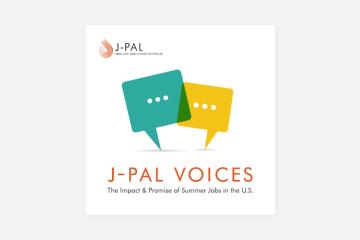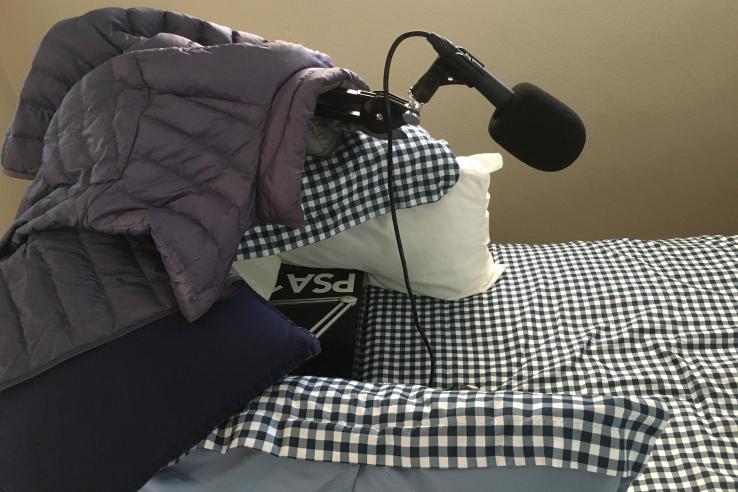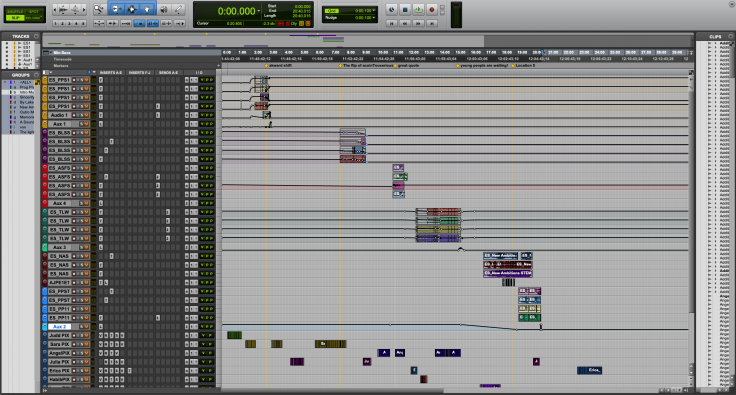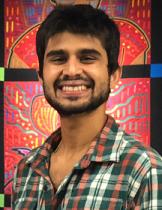
Behind the scenes: Making the J-PAL Voices podcast

With J-PAL Voices, J-PAL North America is making its first foray into podcasting. In producing the podcast, we hope to bring a storytelling lens that showcases the perspectives of the individuals and groups behind the impact. In the conversation below, J-PAL North America’s Rohit Naimpally and Dave Lishansky of David Benjamin Sound take you behind the scenes and reflect on the experience of producing this podcast together.
Rohit: Dave, it has been such a blast working with you on this project. It is no exaggeration to say that this podcast would not have happened without your patience and guidance, from what equipment to procure and how to set up a home “sound booth,” to tips on asking substantive interview questions and scripting a compelling narrative.
So much of this has been a new experience for us and in some ways, it takes me back to my early days at J-PAL as a research assistant. Back then, my ideas of what doing research looked like quickly evolved to acknowledge the reality of getting elbow-deep in data cleaning and debugging code. Similarly, the podcast process has taught me a lot about what goes into being a good interviewer and writer. Would you say that there have been any pleasant surprises or learnings along the way for you?
Dave: Rohit, I have to say, the pleasure has been all mine working with you and the J-PAL North America team on J-PAL Voices. I’ve been incredibly impressed at how quickly you picked up writing a narrative style show. To be honest, it took me a bit to process how to turn Summer Youth Employment Programs into a narrative style podcast. In fact, crafting a show about any kind of research that engages listeners can be a tough task no matter the subject. But learning about the incredible impact of these programs, and hearing the wonderful anecdotes from your interviewees, I’ve become totally enthralled by what seems to lie at the heart of this program: meaningful relationships, balms to serious issues, and lifelong learning for everyone involved.
As I compile the audio for the first episode, I’m getting excited about what’s to come for the show, for listeners, and for J-PAL. In reality, a show like J-PAL Voices, in its intimacy and dedication to hearing the voices on the ground, is the perfect medium to explore the promising research performed by J-PAL North America. People need to hear the stories behind the research and outcomes, from the people directly involved with it, to fully understand the grander meaning behind it all. I can’t wait to see where this season takes us. Rohit, what are you most excited for as we build out this series?
Rohit: Gosh, there are so many things I am excited for! One of them is pulling out and linking the commonalities across interviews to present a coherent narrative that shows the parallels across individuals, places, and programs. During my conversation with Angela Rudolph of Chicago’s Department of Family and Support Services for instance, so much of what she said resonated with what her counterpart Julia Breitman in New York City’s Department of Youth and Community Development had told me. As we build a comprehensive picture of what we know about summer jobs across locations, I am excited to try and link those perspectives to each other. As someone who has experience with doing interviews and building narratives, do you have tips on how people can do this?
Dave: Such a good question! There are a few things I’m always on the lookout for when sifting through interviews for a narrative style show. One is recurring themes. Your example with Angela Rudolph and Julia Breitman is perfect. Looking at the ideas that are present across interviews helps us solidify the arc of the narrative and the details that will bring it to life.
Aside from that, I’m also always on the lookout for stories when searching for content to pull from interviews. Stories make us listen differently. When we hear a story, we engage with the ideas being presented to us in a totally new and more powerful way. A good story helps make things feel real and meaningful for listeners, and that’s something I’m always looking to do when working on a show. I’m curious, Rohit, after all your interviews for J-PAL Voices, is there maybe one story that’s stuck with you?
Rohit: Those are great tips Dave, and ones I am trying to keep in mind as we craft the episodes. To your question: I am going to cheat and pick two, both of which will receive some play in the second episode! My colleague Yiping Li’s story of mentoring kids at the Chicago Public Library, when she herself was just 13 years old, really moved me. I also enjoyed speaking with Rashad Cope; Rashad is the Director of Youth Engagement and Employment in the City of Boston and he speaks of his current job as a means of repaying the communities that raised and nurtured him. I won’t say much more because these stories are worth hearing in Rashad and Yiping’s own words, so I hope listeners tune in.
Shifting tack, I have one final question for you: Could you take us a little bit into the process of stitching together an episode once you have a script? How do you think about the score, silent spaces, and everything else that goes into bringing an episode to life?
Dave: Ahh the secret sauce! I love this question. Much of the beginning stage of stitching together an episode can be tedious: gathering all the interviews and making sure they’re all in the right file format, then bringing them into a Pro Tools session, then picking out the snippets of gold we’ve selected from them, editing them where necessary, mixing them, and finally putting them into place alongside the narration. Once all of that is in order, I listen through a few times and make sure everything that’s there needs to be there, and remove everything that doesn’t. Once I’m satisfied with the speaking parts, I set in on the fun part: scoring.
When I’m going through the first stages, I’m keeping my ear out for moments when speakers tap into the key points. These are often the stories I mentioned earlier, but sometimes it’s a message for the audience, or a particularly poignant reframe or idea. Whenever I hear this, I put a marker on it, which serves as a cue for me to consider putting in music or ending music just before.
A fun fact about the podcasting medium is that silence is just as, if not more, powerful than soundscapes or speaking. Silence after a stretch of music alerts our ears to an important idea. I’m always thinking about how to use the power of silence in my sound design when I’m scoring a show. Finding the right musical elements is also an interesting and really important process. Sometimes the right compositions just jump out and are easy to find. Sometimes they’re hiding deep in the abyss of the internet—I’ve spent weeks at a time sifting through music libraries in search of “the perfect tune” (suffice to say, deadlines are really helpful). I often get obsessive with mixing tunes and need to give my ears critical breaks. This isn’t something you can do effectively for hours and hours on end.
Once everything is good and ready, it looks something like this:

That’s a picture of (most of) the final session for our first episode. There’s so much more to talk about in this process, but I hope that helps for a short explanation!

